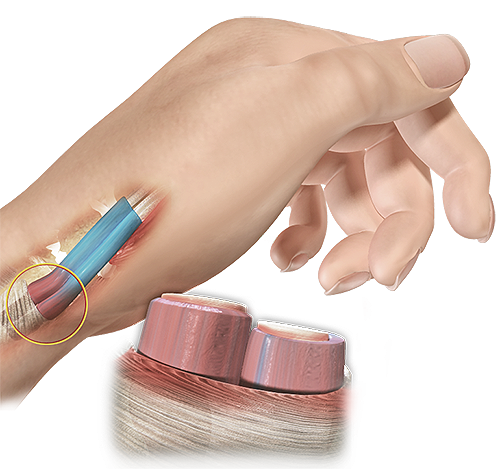De Quervain's Tendinosis

The muscles and bones of the hand are connected by thick flexible tissue called tendons. Tendons are covered by a thin soft sheath of tissue known as synovium. Extensor pollicis brevis and abductor pollicis longus are two tendons located on the thumb side of the wrist. Inflammation and swelling of the tendon sheaths puts pressure on the adjacent nerves and leads to pain and numbness in the thumb side of the wrist.
Strain on these tendons can cause swelling and irritation and lead to a condition called De Quervain's tenosynovitis, which is characterized by inflammation. The condition is also referred to as De Quervain's tendinitis, De Quervain's tendinosis, De Quervain syndrome, or De Quervain's disease.
Causes
The exact cause of De Quervain's tenosynovitis is unknown, but is usually seen in individuals with repetitive hand or wrist movements, injury to the wrist or tendon, and inflammatory conditions such as rheumatoid arthritis and inflammatory arthritis. De Quervain's tenosynovitis is most common in pregnant and middle age women.
Signs and Symptoms
The symptoms of De Quervain's tenosynovitis include pain and tenderness on the side of the wrist at the base of the thumb. You may also have a little swelling and redness in the area. Your symptoms may get worse while making a fist, grasping or gripping things, or turning the wrist. You may experience a "catching" or "snapping" sensation while moving your thumb.
Diagnosis
Your physician diagnoses De Quervain's tenosynovitis by observing your symptoms, medical history, and performing a physical examination of the wrist. De Quervain's tenosynovitis can be confirmed through the Finkelstein test. For this test, your doctor will ask you to make a fist with your fingers covering the thumb and bend the wrist towards the little finger. Pain during this movement will confirm the condition.
Treatment
Treatment of De Quervain's syndrome consists of both non-surgical and surgical therapy.
Non-surgical therapy includes avoiding activities that increase pain and swelling, applying ice, using a splint to support and immobilize the hand, and physical therapy. Anti-inflammatory drugs are helpful in relieving pain and swelling. Your physician may also recommend a corticosteroid injection to reduce the swelling of the tendon sheath.
Surgical therapy: Your physician will recommend surgery based on the severity of your pain symptoms and response to non-surgical treatment methods. The outpatient surgical procedure involves opening or cutting the inflamed part of the tendon sheath to relieve the pressure on the tendon and allow free movement of the wrist. After the surgical procedure, a wrist splint with your thumb and fingers free and mobile is applied for a month. Your surgeon will also instruct you on exercises to strengthen your wrist.


